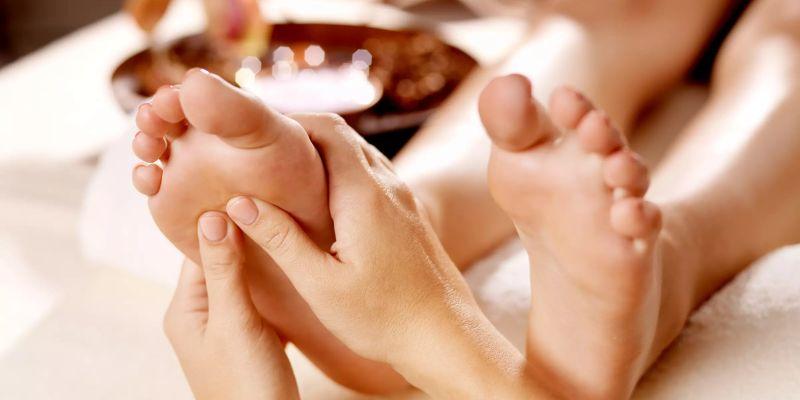What Foot Reflexology Can Do for Bloating and Gut Discomfort

Bloating and gut discomfort are not just physical sensations; they often reflect how the body absorbs day-to-day pressures. The abdomen stores tension easily, especially when someone spends long hours sitting, eats in a hurried state, or experiences emotional strain. Reflexology helps create abdominal ease by working through the foundation of the body the feet where many tension patterns subtly collect.
During a session, the texture of the sole shows signs of internal strain: firmness in the mid-arch that hints at digestive sluggishness, a tight band near the inner heel that reflects lower-abdominal tension, or general sensitivity across the ball of the foot. These areas form a map of how the body is coping, not only physically but also through stress-based holding patterns.
By applying slow, steady pressure across these zones, reflexology encourages the abdominal area to soften from a distance. The touch helps regulate the body’s rhythm, easing the tightness that contributes to bloating sensations. People often describe a feeling of “unclenching” around the belly, an internal exhale that allows the digestive system to settle. This gradual release forms the foundation for deeper comfort, especially when bloating tends to flare during busy or stressful periods. Foot Native incorporates this mindful, whole-body awareness into its approach so the work feels supportive rather than mechanical.
How Gut Stress Responds to Foot-Based Pressure
Many people notice that gut discomfort appears or intensifies during stressful cycles. The digestive system is deeply connected to the nervous system, and when stress rises, the body reroutes energy to deal with the perceived demand. Muscles around the abdomen instinctively tighten, breath becomes shallow, and digestion slows. Reflexology addresses this by nudging the nervous system toward a calmer state through targeted foot pressure, similar to approaches used in Foot Reflexology in Chennai, where specific zones along the arch and upper sole help downshift stress responses.
As the feet receive rhythmic, grounding touch, the body gradually shifts from a reactive mode to a more regulated one. This doesn’t “treat” digestion, but it helps reduce the tension that contributes to gut tightness. People often notice they can breathe more deeply after a session, which directly affects abdominal ease. Deep breathing naturally massages the organs, allowing trapped sensations tightness, heaviness, pressure to ease over time.
The connection between gut and stress means the calming impact of reflexology can play a subtle but meaningful role in how the digestive region feels throughout the day. Whether someone experiences discomfort after long hours at a screen or during emotionally loaded periods, reflexology provides a gentle way to soften the stress-gut loop.
How Circulation Influences Digestive Comfort
Circulation plays a quiet but powerful role in gut comfort. When blood flow becomes sluggish from extended sitting, low hydration, or emotional tension, the abdomen may feel heavy or congested. Reflexology supports circulation by working through the many vascular pathways that begin in the feet. By enhancing these pathways, the body receives fresh movement and warmth that help ease the internal stagnation often linked with bloating sensations.
During a session, the practitioner notices how the feet respond to pressure: warm spots indicating active flow, cooler areas suggesting stagnation, or dense patches showing where tension has settled. As these zones are gently stimulated, circulation begins to shift. The warmth spreads upward, and many clients describe a light, spreading sensation across the lower abdomen. This shift encourages the body to resume its natural movement internally, helping relieve the fullness that accompanies bloating.
The idea isn’t that reflexology “boosts” digestion but that it improves the overall environment the digestive system functions within. When circulation flows well, the body feels more spacious and less burdened. The abdomen, in particular, benefits from this renewed ease, especially when lifestyle habits like long daily commutes or high stress contribute to tension and sluggishness.
Recognizing Relief Patterns the Body Naturally Responds To
Relief from bloating and digestive discomfort often comes in patterns of small, progressive shifts rather than sudden changes. Reflexology supports these patterns by helping the body reconnect with its own rhythm. Gentle pressure applied to specific foot zones encourages a release that moves both downward and inward. Over time, this can reduce the sense of abdominal tightness or heaviness that tends to accumulate through the day.
One common pattern people notice is a gradual softening of the belly. After foot pressure is applied to key points linked to the digestive region, the abdomen loosens, and breathing becomes smoother. Another pattern involves the nervous system responding with a “settling” effect. When the body stops bracing, the gut area naturally feels less compressed. Many people describe a wave of relief that isn’t dramatic but quietly grounding.
A third pattern relates to posture. As foot tension decreases, the hips and lower back begin to relax, allowing the abdomen to sit in a more natural position. This alignment can reduce the physical compression that contributes to bloating sensations. Reflexology doesn’t create these results directly; it supports the conditions that allow the body to access them.
These patterns show why reflexology pairs well with mindful habits such as unhurried meals, gentle movement breaks, and slow breathing. Together, they reinforce the body’s ability to remain comfortable throughout the day.
How Foot-Based Support Helps Ease Everyday Discomfort
Daily life creates many opportunities for bloating and gut discomfort: rushing through meals, long sedentary stretches, emotional tension, inconsistent routines, and irregular sleep. Reflexology offers a grounding counterbalance, especially when it includes approaches like those found in Foot Massage in Velachery, where slow pressure and attentive touch help guide the body back to a steadier state.
When a practitioner follows the feedback from the feet warmth, resistance, and softness they can tailor the session to areas most closely reflecting gut tension. Some people hold discomfort along the inner arch, others at the central ball of the foot, and some along the heel. By working these zones in a calm, gradual pace, the practitioner helps the body unwind the tension patterns that accumulate throughout the day.
Clients often report that they feel lighter, more at ease, or more aware of their own internal rhythm after a session. This awareness becomes part of their long-term comfort. A body that feels supported responds better to daily stressors, and the digestive region, in particular, benefits from this steady state.
A Supportive Path to Gut Ease
Reflexology provides an accessible way to support gut comfort, especially when bloating or abdominal heaviness becomes a regular part of daily life. The feet act as a gateway to releasing stress, improving circulation, and helping the body settle into a more relaxed rhythm. Through thoughtful pressure mapping and attentive touch, reflexology encourages the abdomen to soften and the nervous system to unwind.
This gentle process doesn’t offer quick fixes but long-term patterns of ease. Over time, people often find that their body reacts differently to daily triggers, less gripping, less bloating, and more fluidity in how they digest both food and experience. Reflexology becomes a way of reconnecting with internal balance, one session at a time.
- Art
- Causes
- Best Offers
- Crafts
- Dance
- Drinks
- Film
- Fitness
- Food
- الألعاب
- Festival
- Gardening
- Health
- الرئيسية
- Literature
- Music
- Networking
- أخرى
- Party
- Religion
- Shopping
- Sports
- Theater
- Wellness



